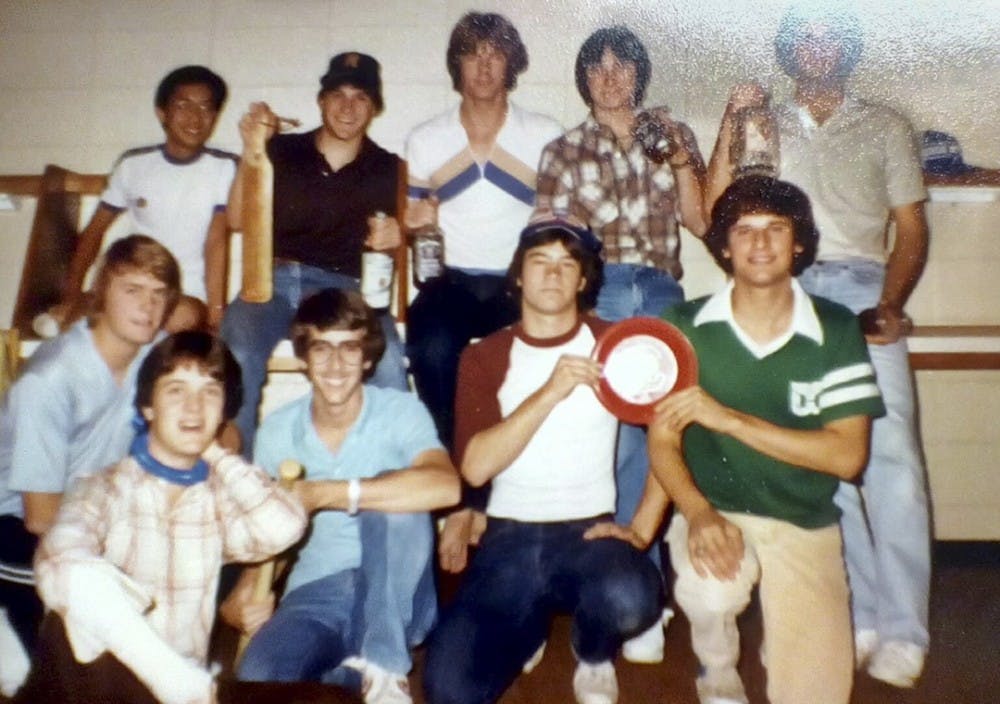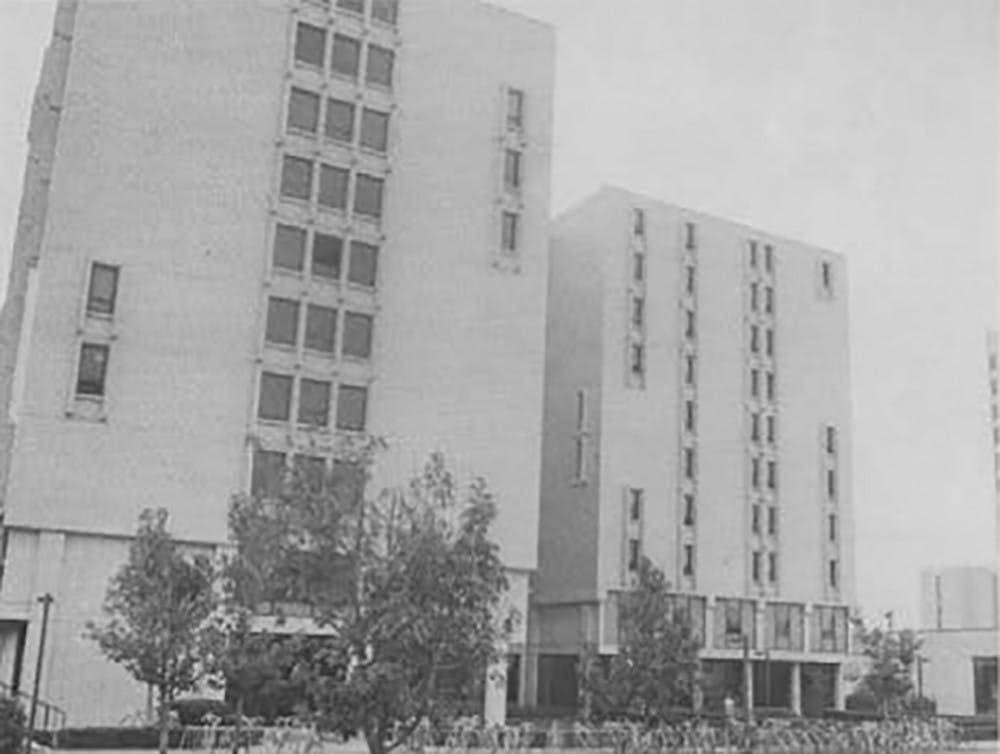Barring any delays in the construction of Campus Village, Bates House will be 51 years old when the wrecking ball arrives in 2020, Bates West a younger 46. By 2022, two shinier buildings capable of housing 1,422 students will stand on their property, with any trace of Scott King's old residence hall permanently wiped from the grounds.

King lived in Bates House from 1979 to 1981 and Bates West from 1981 through graduation in 1983. A political science student, he now works for Wells Fargo in Durham, North Carolina. But he still keeps in regular touch with friends from his residence halls.
"It created a close-knit community, in fact, my best friends now who I talk to probably once every couple weeks, you know, I met when we moved in next to each other," King said.
In 1975, the Garnet & Black yearbook described Bates House as “plush but tiny-roomed” before noting that rent was set at $265 per semester for the coming school year. Bates West, heading into its second academic cycle, set one back $300 per semester. While admitting Bates "wasn't fancy," King still believes it was the best place for him to be on campus.
"I know kids today, they want their own bathrooms and showers and stuff," King said. "But you had real close friendships. We never even locked doors back then."
Now with the S.C. Department of Probation, Parole and Pardon Services, Rodney Rentiers of West Columbia lived in Bates House from January 1979 through his graduation in May 1980. During his time in Bates House, he served as a "hall adviser", then the term for an resident mentor, on the 10th floor.
As the HA for the building's top floor, Rentiers remembers students knocking on his door and asking him unlock to get up to the roof to sunbathe. Overall, he remembers his stint in Bates as one full of friendship and, above all else, fun.
"I met several guys that I'm still friends with today," Rentiers said. "We partied hard and had a great time and laughed a lot."
Still a few years before Congress adjusted the drinking age to 21, the beer was plentiful and cheap, with entry to keg parties costing only a dollar or two. King and his roommates even maintained a bar in their room for a time, selling beer and ice cream to help support themselves.
At parties, guests enjoyed themselves but, as Rentiers remembers it, mostly behaved.
"If they got out of hand, we took care of it, but we had a good time," Rentiers said. "I have very fond memories of parties back then." He adds with a laugh,"My grades probably suffered a little bit from it."
"None of us ever joined a fraternity 'cause we had better parties than the fraternities," John Straubinger boasted. After graduating with a journalism degree in 1983, Straubinger now lives in Sunbury, Ohio, and helps fill IT staff positions in nearby Columbus.
"I learned how to survive on my own, I learned how to live without my mom and dad, learned how to make different friends," Straubinger said of his time in Bates House and Bates West. "I guess the best way to say it, I learned how to be a man."
Looking back, Rentiers agrees that changes to university alcohol policy were necessary from a legal standpoint to keep students safe. But he is it still thankful allowed him to make friends he still connects with.
In one particularly memorable incident, a food fight broke out in the Bates dining hall that resulted in a call to the police. Rentiers said it began as a protest against the quality of the food, which as Straubinger remembered it, was almost universally hated.
"I went to Bates House as a real picky eater, I left eating just about anything," Straubinger said. "I realized the food that I wasn't eating wasn't as bad as this stuff that I'm getting at Bates House."
Though no one told him what would happen the night of the incident, Rentiers knew something was up when students took especially large helpings of Salisbury steak and mashed potatoes.
"I kind of noticed when we were going in and getting our food that everybody was, like, really loading up on food," he said. "Couple of them stood up and started throwing it and I took off."
As Rentiers remembers it, the hall's vice president stood up in an attempt to quell the chaos. By the time he left the dining hall, Rentiers said, he looked as though he had "rolled in a dumpster."
"It wasn't too funny at the time, but looking back on it, it was pretty hilarious," Rentiers said.
After all, with smartphones decades away, residents had to find other ways to fight boredom. According to Straubinger, having a color TV in one's room was out of the ordinary for the time.
"And we only got three stations," Straubinger said.
Plenty was going off-screen, though. Colonial Life Arena wasn’t around, nor Strom, nor Greek Village. But California Dreaming was Crazy Zack’s, a bar and dance club. The Courtyard at Marriott on Assembly Street was a Holiday Inn with a downstairs bar Straubinger often frequented during Happy Hour.
It was an even better time to be a pop or rock fan on campus. Within a three-week span during September and October of 1979, the Bee Gees, AC/DC and Bad Company each played Carolina Coliseum. The Police visited Russell House just nine days following the release of their second album, "Regatta de Blanc."
But tragedy would also mark Bates' disco-era heyday. On Oct. 5, 1979, USC student Mark Houston walked into a Kappa Alpha Psi party in Bates West with a gun. Before the night was over, he killed two people and wounded five. Rentiers remembers the incident vividly.
Police officers had already responded to a report of vandalism in Bates House and as an HA, Rentiers had come downstairs to assist them. When they became aware of gunshots in Bates West, he followed them as they made their way to the next building.
In 2007, The State revisited the incident in the aftermath of the Virginia Tech massacre. According to the ensuing article, prosecutors said Houston had attended a Kappa Alpha Psi party two weeks earlier and became angry when police broke up the party and his cover charge — two dollars — was not refunded.
Whatever the reason, Houston entered the party with a gun and shot five people, killing 21-year-old Terrell Johnson. He then fled the scene and shot two more students on the enclosed walkway above Blossom Street, killing 19-year-old Patrick McGinty. It was USC's last multiple killing until February 2015.
Rentiers knew Johnson as the two formerly lived on the same dorm floor. McGinty, he said, was leaving a party on the tenth floor when he was fatally shot by Houston.
"A lot of people were very upset for a long time afterwards," said Rentiers.
Houston pled guilty to the murders of McGinty and Johnson and charges for carrying a concealed weapon and assault and battery. For the murders, he received a pair of life sentences.
In 1996, Houston received a third life sentence for the fatal stabbing of a fellow inmate at Kirkland Correctional Institution in Columbia. As of Oct. 5, the 38th anniversary of the shooting, he is incarcerated at Lee Correctional Institution in Bishopville.
As fondly as he remembers Bates, King worries students now aren't afforded the same opportunities as apartment-style housing becomes the norm. Especially after he visiting a nephew who used to live in Capstone House.
"I don't think they form as close bonds, close relationships today as they used to," King said. "I mean, they all can retire to their own little room. It's clearly different. I had the same roommate for four years ... I don't think you really see that anymore."

